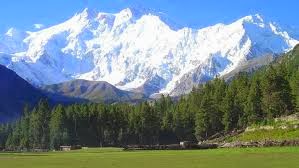Major Rivers Of Pakistan
Water is the most common liquid on Earth. It covers about 71.4% of the
Earth Purewater has no smell, taste, or color. Lakes,
oceans, and rivers are made of water.
Water, a finite commodity, has a direct
bearing on almost all sectors of economy. In Pakistan its importance is more
than ordinary due to the agrarian nature of the economy. Pakistan has
the widest irrigation system in the world. There are five major rivers of
Pakistan which are filled by several small rivers. The most widely spread canal
system is of great importance and supplement to the agriculture of the
country. Among the available resources of water in Pakistan, the river water is
the biggest one. There are five major Rivers Of Pakistan
The Indus:
The creation of the embryonic Indus
river system, the main source of surface water in South Asia, most likely began
50 million years ago when the Indian plate, Gondwanaland, first collided with
Eurasia, Angaraland and
formed the Himalayan Mountains in the Mesozoic era. The
Indus River system comprises of three major reservoirs, 16 Barrages, 2
head-works, 2 Siphons across major rivers 12 inter link canals, 44 canal
systems(23 in Punjab, 14 in Sindh, 5 in Khyber and 2 in Balochstan) and more than 107000
water courses. The aggregate length of the canals is about 56073 km. It
originates from singikahad near Manshwar Lake. Important engineering’s Tarbela
Dam and Gazi Brotha Hydro Power Project.
The Chanab:
The Chenab river originates in the Kulu and
Kangra districts of the Himachal pardesh, provinces of India. The two chief
Streams of Chenab—the Chandr and the Bangr—rise elevation of 16000 feet. These
join at Tandi in the state of Jammu and Kashmir. Feed by inumerable tributaries
on the long journey from its headwaters, the river gains immense power region
above Kashmir. In enters Pakistan through Sialkot near Diawara village.
The chenab flows through the alluvial
plains of the Punjab province. It is then joined by the Jehlum Riverat
at Trimmu, 64 km downstrons of Trimmu, the river Ravi joins it. The Satluj
joins Chenab upstream of Punjnad and finally at above 64 km below Punjnad it
meets of river Sindh at Mithankot. The river Chenab has Marala, Khanki,
Punjnad, Trimmu and Qadirabed Barrage and Marala
River Sutlej:
The longest of the rivers that give
Punjab (meaning “Five River”) originates in western Tibet in the Kailas
mountain ranges. Flowing Northwest and West – South West through Himalayan
gorges, it crosses Himachal Pardesh state (India) and enters the Punjab plains
in Hoshiarpur district, Punjab state.
Continuing Southwest in a broad channel, it relieves the Beas River and from
105 km Indo-Pak border before entering Pakistan and joining the chenab river
west of Bahawal Pur.
The Jhelum:
It is a large eastern tributary of
the Indus. It rises from a deep spring of Vernag, in the Indian-held Jammu and
Kashmir state. The river moves North-West ward from the Northern
slope of the Pir Panjab range to
Wular Lake. At Mazaffarabad, the Jhelum joins
the Kishanganga river and then bends Southward forming part or the border
between Azad Kashmir and Khyber Pakhtunkhawa. Near Mangla, it breaks through
the Siwalik range into broad alluvial plains. At Jhelum town the river turns
South-West ward to Khushab .The Mangla Dam is one of the biggest dams of
Pakistan built on Jhehlum river and its reservoir irrigates about 3,000,000
acres of land and has an installed capacity of 300 MW of electricity.
The Ravi:
The Ravi is the smallest of the five main
eastern tributaries of Indus. It rises in the Himalauans in Himachal Pardesh
(India) and flows west – Northwest past Chamba, turning Southwest at the
boundary of Jammu and Kashmir. It flows past Lahore and turns west near kamalia,
emplying into the chenab
The Indus River basin is the most important yet heavily degraded river
system in Pakistan. Ecological degradation in the basin is fast increasing, and
threatens the livelihoods of millions who depend on its rich ecosystem.
The construction of dams on the Indus,
both for irrigation and power generation, as well as the construction of
drainage systems for agricultural run-off, are the major causes for the
downward spiral of the Indus basin. The largest dam on the Indus is Tarbela
Dam, which forced almost 100,000 people to leave their lands and homes. The
World Bank-sponsored Left Bank Outfall Drain (LBOD) Project is one of the main
drainage systems in the delta. These projects are part of a wider set of
infrastructure projects, the so-called Indus Basin Irrigation System (IBIS),
which is the world’s largest irrigation system.
Affected communities in the Indus delta
have been actively protesting the devastating impacts of the existing water
development projects. International Rivers and other civil society
organizations and networks are working with these communities to promote
alternatives to the planned large dams.
The Indus System of rivers In the Indus basin
comprises of above mentioned five rivers. The are all combine into one river
near Mithan Kot in Punjab, and flow into
Arabian Sea

































.jpg)


















